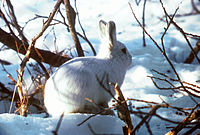Mountain hare
| Mountain hare | ||||||||||||
|---|---|---|---|---|---|---|---|---|---|---|---|---|

Mountain hare ( Lepus timidus ) |
||||||||||||
| Systematics | ||||||||||||
|
||||||||||||
| Scientific name | ||||||||||||
| Lepus timidus | ||||||||||||
| Linnaeus , 1758 |
The mountain hare ( Lepus timidus ) is the family of rabbits belonging (Leporidae) type . In Europe it belongs to the vertebrate fauna of the Alps and, together with the Ptarmigan, is one of the few animal species that are well adapted to the boreo-alpine habitat.
Distribution area
Mountain hares are found in large parts of northern Eurasia . In Europe they live in Scandinavia , Scotland and Ireland , in the Alpine region as well as in the Baltic and Eastern Europe, in Asia all over Siberia to Mongolia and northern China and on the Japanese island of Hokkaidō . The species was introduced in England and the Faroe Islands . The isolated population in the Alps lives at altitudes of 1300 m to 3800 m , occasionally animals have been spotted in winter even at lower altitudes of up to 700 m .
description
With an average weight of around three kilograms and almost 40 to 60 centimeters in length, it is slightly smaller than the brown hare . His coat change from a gray-brown summer dress to a white winter dress is known. However, this depends on the region: In Ireland he never puts on a white winter dress, but wears it for five months in the European part of Russia and seven months in some North Asian areas. The mountain ptarmigan ( Lepus timidus varronis ) is only white in winter. From the white winter coat, it shows a transition coat that is clearly more piebald. In summer it is gray-brown, around November the fur turns white and only the outer tips of the ears still have black hair. The Nordic Mountain Hare ( Lepus timidus timidus ) is mostly white all year round. Their fur is used to camouflage them in the white, snowy surroundings. The adaptation of the ear length to the different climatic conditions is important. Since the rabbits regulate the blood circulation with the help of their ears and thus compensate for heat loss, the colder their habitat, the shorter their ears are.
The mountain hare is one of the medium-sized rabbits. In winter it is reminiscent of a well-fed rabbit with its body shape. Compared to the brown hare, it also looks fuller in summer and the ears are noticeably shorter. During the winter, the paws are very hairy, which increases the contact area and allows him to cross snow cover without sinking too deeply.
Habitat and way of life
The habitat of the mountain hares are tundra areas , forests and moors. They are predominantly nocturnal and spend the day hidden in a pit in the snow or in the ground. In contrast to most other real hares , mountain hares are often sociable.
food
The food of the mountain hare depends on the habitat and season and consists of grasses, herbs, heather, twigs, bark and other things.
Reproduction
Two or three times a year the female gives birth to two to five young animals, the gestation period is relatively long for rabbits at seven to eight weeks. The newborns are hairy and grow relatively quickly; they are weaned after just four weeks.
threat
The populations of the mountain hare are subject to strong fluctuations. The reasons for this are persecution by robbers, hunger and infestation by parasites. In general, they do not count among the threatened species, only the population in the Alpine region is considered threatened. The main impetus here is the continuing climate change combined with competition and hybridization with the brown hare advancing from the lower areas and with the reduction in possible habitat area; but increasing mountain tourism can also have a negative effect on the mountain hare.
Mountain hares are not hunted in Germany and Liechtenstein. In Austria there is a peculiarity, there the hunting statistics do not provide any information about the hunted individuals, as there is no distinction between snow and brown hares . Between 2013 and 2015, around 1,200 mountain hares were shot each year in Switzerland. The main share (80 percent) is made up of the canton of Graubünden, with around 1,000 animals killed each year. The hunting season in Switzerland is from October 1st to December 31st.
Related species
Two species living in North America have a similar way of life and were previously regarded as subspecies of the mountain hare, but are now mostly regarded as separate, closely related species: the polar hare ( Lepus arcticus ) lives in Greenland and northern Canada ( Nunavut , northern Québec and Newfoundland ). He lives together in groups of up to 300 animals. The Alaskan Hare ( Lepus othus ) comes in western and southern Alaska and on the eastern tip of Siberia before. It is noticeably large and short-eared and, unlike most other rabbits, only gives birth to offspring once a year.
literature
- Maik Rehnus: The mountain hare in the Alps. A survivor with an uncertain future . Haupt Verlag, Bern 2013, ISBN 978-3-258-07846-5 .
- Jacques Gilliéron (author), Claude Morerod (photographer): Animals of the Alps. The vertebrates . SAC Verlag, Bern 2005, ISBN 3-85902-238-5 .
Web links
- Lepus timidus in the endangered Red List species the IUCN 2008. Posted by: AT Smith, C. H. Johnston, 2008. Accessed on January 1 of 2009.
- Mountain hare with photo
Individual evidence
- ↑ Maik Rehnus: The mountain hare in the Alps. A survivor with an uncertain future , p. 21
- ↑ Gilliéron et al. Animals of the Alps. The vertebrates , p. 49
- ↑ Maik Rehnus: The mountain hare in the Alps. A survivor with an uncertain future , pp. 13–81.
- ↑ Federal Hunting Statistics 2000-2015 , accessed on July 29, 2017.


